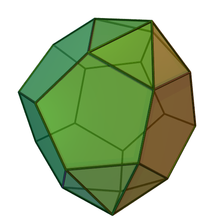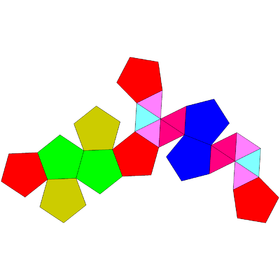In geometry, the metabiaugmented dodecahedron is one of the Johnson solids (J60). It can be viewed as a dodecahedron with two pentagonal pyramids (J2) attached to two faces that are separated by one face. (The two faces are not opposite, but not adjacent either.) When pyramids are attached to a dodecahedron in other ways, they may result in an augmented dodecahedron, a parabiaugmented dodecahedron, a triaugmented dodecahedron, or even a pentakis dodecahedron if the faces are made to be irregular.

Geometry is a branch of mathematics concerned with questions of shape, size, relative position of figures, and the properties of space. A mathematician who works in the field of geometry is called a geometer.

In geometry, a Johnson solid is a strictly convex polyhedron, which is not uniform, and each face of which is a regular polygon. There is no requirement that each face must be the same polygon, or that the same polygons join around each vertex. An example of a Johnson solid is the square-based pyramid with equilateral sides (J1); it has 1 square face and 4 triangular faces.
In geometry, a dodecahedron is any polyhedron with twelve flat faces. The most familiar dodecahedron is the regular dodecahedron, which is a Platonic solid. There are also three regular star dodecahedra, which are constructed as stellations of the convex form. All of these have icosahedral symmetry, order 120.
A Johnson solid is one of 92 strictly convex polyhedra that have regular faces but are not uniform (that is, they are not Platonic solids, Archimedean solids, prisms, or antiprisms). They were named by Norman Johnson, who first listed these polyhedra in 1966. [1]

In geometry, a polyhedron is a solid in three dimensions with flat polygonal faces, straight edges and sharp corners or vertices. The word polyhedron comes from the Classical Greek πολύεδρον, as poly- + -hedron.
A regular polyhedron is a polyhedron whose symmetry group acts transitively on its flags. A regular polyhedron is highly symmetrical, being all of edge-transitive, vertex-transitive and face-transitive. In classical contexts, many different equivalent definitions are used; a common one is that faces are congruent regular polygons which are assembled in the same way around each vertex.
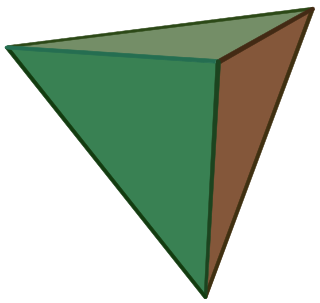
A uniform polyhedron is a polyhedron which has regular polygons as faces and is vertex-transitive. It follows that all vertices are congruent.

In geometry, the triaugmented triangular prism or tetracaidecadeltahedron is one of the Johnson solids (J51). As the name suggests, it can be constructed by attaching square pyramids (J1) to each of the three equatorial faces of the triangular prism. It is a deltahedron.

In geometry, the elongated pentagonal pyramid is one of the Johnson solids (J9). As the name suggests, it can be constructed by elongating a pentagonal pyramid (J2) by attaching a pentagonal prism to its base.

In geometry, the elongated square pyramid is one of the Johnson solids (J8). As the name suggests, it can be constructed by elongating a square pyramid (J1) by attaching a cube to its square base. Like any elongated pyramid, it is topologically self-dual.
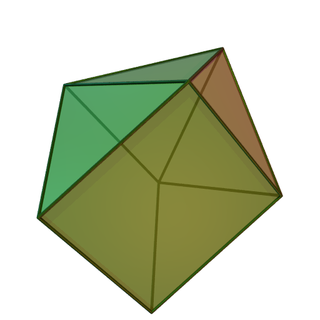
In geometry, the augmented triangular prism is one of the Johnson solids (J49). As the name suggests, it can be constructed by augmenting a triangular prism by attaching a square pyramid (J1) to one of its equatorial faces. The resulting solid bears a superficial resemblance to the gyrobifastigium (J26), the difference being that the latter is constructed by attaching a second triangular prism, rather than a square pyramid.

In geometry, the biaugmented triangular prism is one of the Johnson solids (J50). As the name suggests, it can be constructed by augmenting a triangular prism by attaching square pyramids (J1) to two of its equatorial faces.
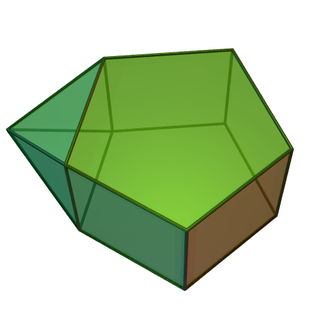
In geometry, the augmented pentagonal prism is one of the Johnson solids (J52). As the name suggests, it can be constructed by augmenting a pentagonal prism by attaching a square pyramid (J1) to one of its equatorial faces.

In geometry, the biaugmented pentagonal prism is one of the Johnson solids (J53). As the name suggests, it can be constructed by doubly augmenting a pentagonal prism by attaching square pyramids (J1) to two of its nonadjacent equatorial faces.

In geometry, the augmented hexagonal prism is one of the Johnson solids (J54). As the name suggests, it can be constructed by augmenting a hexagonal prism by attaching a square pyramid (J1) to one of its equatorial faces. When two or three such pyramids are attached, the result may be a parabiaugmented hexagonal prism, a metabiaugmented hexagonal prism or a triaugmented hexagonal prism.

In geometry, the parabiaugmented hexagonal prism is one of the Johnson solids (J55). As the name suggests, it can be constructed by doubly augmenting a hexagonal prism by attaching square pyramids (J1) to two of its nonadjacent, parallel (opposite) equatorial faces. Attaching the pyramids to nonadjacent, nonparallel equatorial faces yields a metabiaugmented hexagonal prism.

In geometry, the metabiaugmented hexagonal prism is one of the Johnson solids (J56). As the name suggests, it can be constructed by doubly augmenting a hexagonal prism by attaching square pyramids (J1) to two of its nonadjacent, nonparallel equatorial faces. Attaching the pyramids to opposite equatorial faces yields a parabiaugmented hexagonal prism.

In geometry, the triaugmented hexagonal prism is one of the Johnson solids (J57). As the name suggests, it can be constructed by triply augmenting a hexagonal prism by attaching square pyramids (J1) to three of its nonadjacent equatorial faces.

In geometry, the augmented dodecahedron is one of the Johnson solids (J58), consisting of a dodecahedron with a pentagonal pyramid (J2) attached to one of the faces. When two or three such pyramids are attached, the result may be a parabiaugmented dodecahedron, a metabiaugmented dodecahedron or a triaugmented dodecahedron.

In geometry, the parabiaugmented dodecahedron is one of the Johnson solids (J59). It can be seen as a dodecahedron with two pentagonal pyramids (J2) attached to opposite faces. When pyramids are attached to a dodecahedron in other ways, they may result in an augmented dodecahedron, a metabiaugmented dodecahedron, a triaugmented dodecahedron, or even a pentakis dodecahedron if the faces are made to be irregular.

In geometry, the triaugmented dodecahedron is one of the Johnson solids (J61). It can be seen as a dodecahedron with three pentagonal pyramids (J2) attached to nonadjacent faces.

In geometry, the triangular orthobicupola is one of the Johnson solids (J27). As the name suggests, it can be constructed by attaching two triangular cupolas (J3) along their bases. It has an equal number of squares and triangles at each vertex; however, it is not vertex-transitive. It is also called an anticuboctahedron, twisted cuboctahedron or disheptahedron.
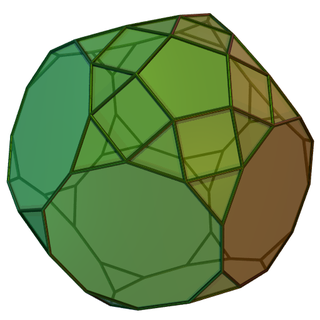
In geometry, the augmented truncated dodecahedron is one of the Johnson solids (J68). As its name suggests, it is created by attaching a pentagonal cupola (J5) onto one decagonal face of a truncated dodecahedron.

In geometry, the parabiaugmented truncated dodecahedron is one of the Johnson solids (J69). As its name suggests, it is created by attaching two pentagonal cupolas (J5) onto two parallel decagonal faces of a truncated dodecahedron.
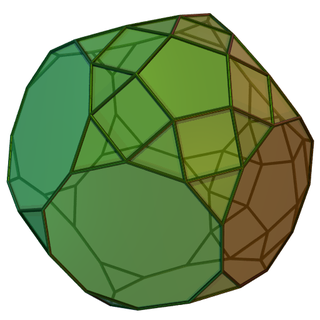
In geometry, the metabiaugmented truncated dodecahedron is one of the Johnson solids (J70). As its name suggests, it is created by attaching two pentagonal cupolas (J5) onto two nonadjacent, nonparallel decagonal faces of a truncated dodecahedron.
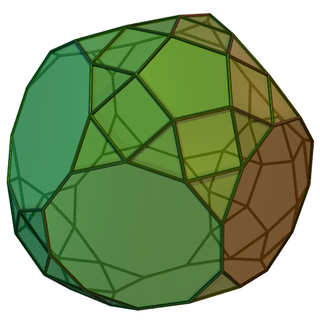
In geometry, the triaugmented truncated dodecahedron is one of the Johnson solids (J71); of them, it has the greatest volume in proportion to the cube of the side length. As its name suggests, it is created by attaching three pentagonal cupolas (J5) onto three nonadjacent decagonal faces of a truncated dodecahedron.
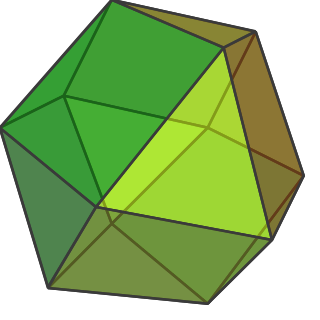
In geometry, a bicupola is a solid formed by connecting two cupolae on their bases.
